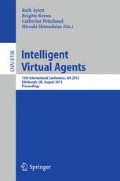Abstract
An ideal verbally controlled virtual actor would allow the same interaction as instructing a real actor with a few words. Our goal is to create virtual actors that can be controlled with natural language instead of a predefined set of commands. In this paper, we present results related to a questionnaire where people described videos of human locomotion using verbs and modifiers. The verbs were used almost unanimously for many motions, while modifiers had more variation. The descriptions from only one person were found to cover less than half of the vocabulary of other participants. Further analysis of the vocabularies against the numerical descriptors calculated from the captured motions shows that verbs appeared in closed areas while modifiers could be scattered to disconnected clusters. Based on these findings, we propose modeling verbs with a hierarchical vocabulary and modifiers as transitions in the space defined by the numerical qualities of motions.
Access this chapter
Tax calculation will be finalised at checkout
Purchases are for personal use only
Preview
Unable to display preview. Download preview PDF.
References
Ahad, M., Tan, J., Kim, H., Ishikawa, S.: Action dataset - A survey. In: Proc. of SICE Annual Conference 2011 (SICE 2011), pp. 1650–1655 (2011)
Förger, K., Takala, T., Pugliese, R.: Authoring Rules for Bodily Interaction: From Example Clips to Continuous Motions. In: Nakano, Y., Neff, M., Paiva, A., Walker, M. (eds.) IVA 2012. LNCS, vol. 7502, pp. 341–354. Springer, Heidelberg (2012)
Blumberg, B., Galyean, T.: Multi-level direction of autonomous creatures for real- time virtual environments. In: Mair, S.G., Cook, R. (eds.) Proc. of SIGGRAPH 1995, pp. 47–54. ACM, New York (1995)
Perlin, K., Goldberg, A.: Improv: a system for scripting interactive actors in virtual worlds. In: Proc. of SIGGRAPH 1996, pp. 205–216. ACM, New York (1996)
Vilhjálmsson, H.H., et al.: The behavior markup language: Recent developments and challenges. In: Pelachaud, C., Martin, J.-C., André, E., Chollet, G., Karpouzis, K., Pelé, D. (eds.) IVA 2007. LNCS (LNAI), vol. 4722, pp. 99–111. Springer, Heidelberg (2007)
Hachimura, K., Takashina, K., Yoshimura, M.: Analysis and evaluation of dancing movement based on LMA. In: IEEE International Workshop on Robot and Human Interactive Communication 2005 (ROMAN 2005), pp. 294–299. IEEE (2005)
Talbot, C., Youngblood, G.: Spatial Cues in Hamlet. In: Nakano, Y., Neff, M., Paiva, A., Walker, M. (eds.) IVA 2012. LNCS, vol. 7502, pp. 252–259. Springer, Heidelberg (2012)
Honkela, T.: Raitio, j., Lagus, K., Nieminen, I., Honkela, N., Pantzar, M.: Subjects on objects in contexts: Using GICA method to quantify epistemological subjectivity. In: Proc. of International Joint Conference on Neural Networks (IJCNN 2012), pp. 2875–2883 (2012)
Poppe, R.: A survey on vision-based human action recognition. Image and Vision Computing 28(6), 976–990 (2010)
Vondrick, C., Patterson, D., Ramanan, D.: Efficiently Scaling up Crowdsourced Video Annotation. International Journal of Computer Vision 101(1), 184–204 (2012)
Rose, C., Bodenheimer, B., Cohen, M.F.: Verbs and Adverbs: Multidimensional Motion Interpolation Using Radial Basis Functions. IEEE Computer Graphics and Applications 18(5), 32–40 (1998)
Kovar, L., Gleicher, M.: Automated Extraction and Parameterization of Motions in Large Data Sets. In: Marks, J. (ed.) Proc. of SIGGRAPH 2004, pp. 559–568. ACM, New York (2004)
Shoemake, K.: Animating rotation with quaternion curves. ACM SIGGRAPH Computer Graphics 19(3), 245–254 (1985)
Lindén, K., Carlson, L.: FinnWordNet - WordNet på finska via översättning (In English: FinnWordNet - Finnish WordNet by Translation). LexicoNordica - Nordic Journal of Lexicography 17, 119–140 (2010)
Bernhardt, D., Robinson, P.: Detecting affect from non-stylised body motions. In: Paiva, A.C.R., Prada, R., Picard, R.W. (eds.) ACII 2007. LNCS, vol. 4738, pp. 59–70. Springer, Heidelberg (2007)
Author information
Authors and Affiliations
Editor information
Editors and Affiliations
Rights and permissions
Copyright information
© 2013 Springer-Verlag Berlin Heidelberg
About this paper
Cite this paper
Förger, K., Honkela, T., Takala, T. (2013). Impact of Varying Vocabularies on Controlling Motion of a Virtual Actor. In: Aylett, R., Krenn, B., Pelachaud, C., Shimodaira, H. (eds) Intelligent Virtual Agents. IVA 2013. Lecture Notes in Computer Science(), vol 8108. Springer, Berlin, Heidelberg. https://doi.org/10.1007/978-3-642-40415-3_21
Download citation
DOI: https://doi.org/10.1007/978-3-642-40415-3_21
Publisher Name: Springer, Berlin, Heidelberg
Print ISBN: 978-3-642-40414-6
Online ISBN: 978-3-642-40415-3
eBook Packages: Computer ScienceComputer Science (R0)

